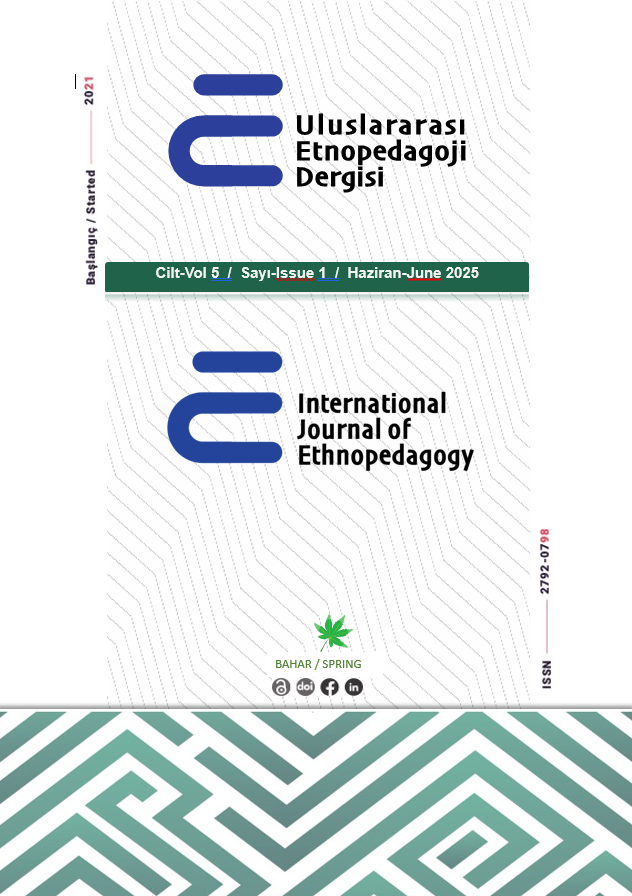What Fairy Tales Tell Us
DOI:
https://doi.org/10.5281/zenodo.15755731Keywords:
Yücel Feyzioğlu, What Do Fairy Tales Tell Us?, Book reviewAbstract
Children's literature is all oral, written and written content that is created in accordance with the linguistic and strategic development of children between the ages of 2-14, childhood and adolescence education, allows them to explore their emotional and intellectual worlds from different perspectives and enriches their imagination, while also helping them understand the realities of life and gain an artistic perspective (Ciravoğlu, 1999). Şirin (2007) defined children's literature as a transitional period literature where the understanding of children and freedom is placed at its core; organized in accordance with the child's interests, feelings and attitudes; where the content and characters are expressed in a simple and clear language that allows them to play games, helps the child gain a reading habit, develops in the child's sensory world and takes a step towards adulthood. One of the basic functions of children's literature is to ensure that children gain a reading habit and develop a love of reading through quality products (Duran, 2019). As in Sever (2010), the characters in the works provide cultural contributions to the culture of reading by revealing the children's bond with the hero and the desire to go out with the heroes. Children's literature products ensure that the child develops his/her language, acquires new words and changes the rules of the language (Gönen, Katrancı, Uygun and Uçuk, 2011). In addition, these works enable the child to gain different perspectives, think critically and originally, enrich his/her vocabulary (Yıldırım-Bilgen, 2017) and use the language correctly (Sis and Gökçe, 2009). Children's literature works teach correct developments and rules that society should pay attention to; they provide values such as honesty, cooperation and kindness; in short, they prepare the child for life (Arseven, 2005). There are many types of literature included in children's literature. Types such as fairy tales, epics, legends, lullabies, fables, essays, jokes, stories, novels, stories, biographies, children's poems, travel writings, nursery rhymes, riddles, children's theater, and cartoons-comics are the basic works that can be examined in this field (Yıldız and Öztürk Samur, 2018). One of these types, fairy tales, is a form of verbal narration in which the heroes consist of countless extraordinary beings, are told entirely based on imagination, and end with a happy ending stopped by nursery rhymes (Gedik, 2020). The fact that many types of children's literature such as rhymes, paragraphs, riddles, and legends are encountered in fairy tales shows that fairy tales are an inclusive genre. For this reason, fairy tales are vocabulary and rich texts in children's literature works (Baş, 2006). First of all, fairy tales, which enable people to acquire and develop their language skills (Sanders, 2013), play an important role in the transfer and adoption of national and universal values (Karatay, 2007). Nevertheless, fairy tales, which have an important place in developing children's imagination and perceiving abstract concepts (Karatay, 2007), prepare children for real life by contributing to emotional and spiritual development (Gedik, 2020). Finally, fairy tales also play an active role in the transfer of cultural identity to future generations (Arıcı, 2012). This is emphasized in the work titled "What Do Fairy Tales Tell Us?" written by Yücel Feyzioğlu, which examines the place of fairy tales in our lives in detail.
References
Arıcı, A.F. (2012). Masalın Sesi. Ankara: Pegem Akademi.
Arseven, T. (2005). Mesaj Açısından Çocuk Kitapları. Hece Çocuk Edebiyatı Özel Sayısı, S:104-105.
Baş, B. (2006). 1985-2005 Yılları Arasında Çocuk Edebiyatı Sahasında Yazılmış Tahkiyeli Metinlerin Sözvarlığı Üzerine Bir Araştırma. Ankara: Gazi Üniversitesi (Yayımlanmamış Doktora Tezi).
Ciravoğlu, Ö. (1999). Çocuk edebiyatı. İstanbul: Esin Yayınevi.
Duran, M. (2019). Tarık Dursun K.nın çocuk hikâyelerinin atasözleri ve deyimler açısından incelenmesi. Yayımlanmamış yüksek lisans tezi). Zonguldak Bülent Ecevit Üniversitesi Sosyal Bilimler Enstitüsü, Zonguldak.
Feyzioğlu, Yücel. (2019). Masallar Bize Ne Anlatır? Doğubatı Yayınları.
Gedik, S. (2020). Masalların Eğitimsel İşlevleri. Sosyal Bilimler ve Eğitim Dergisi, 3(1), 356-367.
Gönen, M., Katrancı, M., Uygun, M. & Uçuş, Ş. (2011). İlköğretim birinci kademe öğrencilerine yönelik çocuk kitaplarının, içerik, resimleme ve fiziksel özellikleri açısından incelenmesi. Eğitim ve Bilim, 36(160).
Karatay, H. (2007). “Dil Edinimi ve Değer Öğretimi Sürecinde Masalın Önemi ve İşlevi”. Türk Eğitim Bilimleri Dergisi.5(3), 463-475.
Sever, S. (2010). Çocuk ve edebiyat. Ankara: Tudem Yayıncılık.
Sis, N. ve Gökçe, B. (2009). Gülten Dayıoğlu’nun çocuk öykülerinde yansımalar ve kalıp sözler. Turkish Studies, International Periodical For the Languages, Literature and History of Turkish or Turkic, 4(3), 1976-1989.
Şirin, M. R. (2007). Çocuk edebiyatına eleştirel bir bakış- çocuk edebiyatı nedir ne değildir? Ankara: Kök Yayıncılık.
Yıldırım-Bilgen, D. (2017). Çocuk edebiyatı alanındaki eserlerin söz varlığı öğelerine ilişkin karşılaştırmalı bir inceleme. International Journal of Languages’ Education and Teaching, 5(3), 145-171.
Yıldız, F. E. ve Öztürk-Samur, A. (2018, Aralık). Türkiye’de çocuk edebiyatı alanında yapılan lisans üstü çalışmaların incelenmesi. International Congress of Human Studies. Uluslararası İnsan Çalışmaları Kongresi’nde (6 Aralık 2018) sunulmuş bildiri, Ankara.
Downloads
Published
How to Cite
Issue
Section
License
Copyright (c) 2025 Ezgi Çetinkaya Özdemir

This work is licensed under a Creative Commons Attribution 4.0 International License.



